The NHL season is tentatively expected to resume with a post-season tournament beginning at the end of July, with 24 teams participating, including eight teams per conference in a play-in round and the top four teams per conference in a round-robin.
Projecting how teams will look coming out of the 4.5-month layoff gets particularly interesting when examining the goaltenders. Amazingly, of the 24 teams slated to compete, I count 11 with unsettled starting-goalie roles. That’s 45.8 percent. Some of these platoon situations have a 1A who holds an edge right now, but the phase-3 training camps will determine the starters for many teams. The competition is wide open and will shape the post-season, which includes best-of-five series for the qualifying round.
Here’s a look at the cloudy creases and who holds the edge in each battle for now.
Play-in Round
EDMONTON OILERS (5-West): Mikko Koskinen vs. Mike Smith
Smith started 37 games to Koskinen’s 33 this season, but Koskinen did much better work with his chunk of the pie. His .917 save percentage dwarfed Smith’s .902 mark. Koskinen’s grip on the starting job tightened after the all-star break, when he held a .934 SP and appeared in 11 games, whereas Smith only improved to .905 in 13 appearances. Performance wise, Koskinen has been the far superior goalie. He got a lot less help than Smith, too. Among 66 goalies who logged at least 500 minutes at 5-on-5, Koskinen’s difficulty of shot quality placed him sixth in expected goals against per 60, whereas Smith sat 48th. Koskinen graded out above average on the year, ranking 22nd in goals saved above average per 60, whereas Smith graded out as one of the league’s worst netminders, sitting 60th.
So why is this even a controversy? Koskinen has 0.0 games of NHL playoff experience. Smith has 24, during which he’s been lights out. He’s 38 now, but even last year, at 37, he was arguably the only reason the Calgary Flames didn’t get swept. Among goalies with 20 or more games played, his .938 career post-season SP ranks first all-time. Is it possible the Oilers prefer an experienced netminder to compete opposite the Chicago Blackhawks’ two-time Stanley Cup champ, Corey Crawford? During Smith’s outstanding 2011-12 playoff run with the Arizona Coyotes, his coach was Dave Tippett. Smith’s coach in Edmonton now: Dave Tippett.
The edge: Performance wise, Koskinen has more than earned the first chance, so he has the slight edge going into camp. If he struggles early against Chicago, however, few starters will have shorter leashes given the backup’s level of experience.
NASHVILLE PREDATORS (6-West): Juuse Saros vs. Pekka Rinne
Even peak Pekka Rinne was wobbly in Nashville’s crease at times in the playoffs. In 2017-18, his Vezina Trophy season, Rinne wound up pulled at home in Game 7 against the Winnipeg Jets. Two years later, with Rinne 37 years old, Saros seemed take over the starting job for good heading into the March-12 season shutdown. Both goalies had struggled for much of the season. At the all-star break, Rinne and Saros held SPs of .899 and .895, respectively. But as the Preds started to find themselves after swapping out coach Peter Laviolette for John Hynes, Saros really pulled away from Rinne. Post-all-star-break, Saros went 11-4-0 with a 2.14 goals-against average and .936 SP across 17 appearances. Rinne got worse: 2-4-1, 4.12 GAA, .884 SP. The crease battle appeared to be over. For the first time in 89 games, someone else might start a playoff contest for Nashville.
But as The Athletic’s Adam Vingan reported earlier this month, after the long layoff, Hynes still sees the Preds’ starting goalie gig as an open competition.
The edge: If Saros doesn’t get the first crack after being the No. 1 reason Nashville clawed back into the playoff picture, it’ll be a mini travesty. Yes, Rinne has all that playoff experience, but it’s not all good playoff experience, as Rinne also carries the history of post-season implosions. He holds an SP below .910 in five of his eight playoff years. Saros gets the No. 1 spot for now, but it’s open for Rinne to win it back during camp.
MINNESOTA WILD (10-West): Alex Stalock vs. Devan Dubnyk vs. Kaapo Kahkonen
In this case, playoff experience is inversely proportional to each netminder’s effectiveness this season. Having turned 34 in May, Dubnyk appeared to decline in 2019-20. He posted easily his worst numbers since his career renaissance began with the help of Arizona Coyotes goaltending coach Sean Burke in 2014-15. Dubnyk’s 3.35 GAA and .890 SP both ranked second-last in the league behind Detroit’s Jimmy Howard among goalies who appeared in at least 25 games this year, and Dubnyk ranked near the bottom of the league in GSAA/60. He lost the starting job to Alex Stalock before the March-12 shutdown. The reason why Dubnyk isn’t ruled out of the competition: his 26 career playoff starts. Stalock, a career backup, was a major contributor to the Wild’s quiet surge up the Western Conference standings in the winter. He went 9-3-1 with a 2.22 GAA and .924 SP after the all-star break. On the year, Stalock graded out as a slightly above average goalie in GSAA/60, but from the all-star break on, he was eighth in the league among goalies with at least 500 minutes played at 5-on-5. He earned his No. 1 status.
And then there’s the prospect Kahkonen, who won three of his five decisions when he got some work in November and December and was phenomenal with AHL Iowa this season, going 25-6-3 with a 2.07 GAA and .927 SP. With the NHL allowing for expanded rosters this post-season, Kahkonen will be in the mix.
The edge: It’s Stalock’s to lose. He was easily Minnesota’s best netminder this season. He only has four playoff games and one start to his name, but he has a .931 SP across those 165 minutes, for what it’s worth. That said, it sounds like the Wild are allowing for an open competition in camp, as coach Dean Evason told The Star Tribune’s Sarah McLellan earlier this month.
ARIZONA COYOTES (11-West): Darcy Kuemper vs. Antti Raanta
The Coyotes have no bad choice here. Kuemper and Raanta were both excellent this season. Not only did they both sit inside the league’s top 25 in GSAA/60, but Arizona’s third option, Adin Hill, ranked fourth among goalies with 500-plus minutes at 5-on-5 after doing exemplary work while Kuemper was hurt. The Coyotes are loaded in net.
The edge: Coach Rick Tocchet has options, but Kuemper has a reasonably decisive edge here. Among goalies who played 1,000-plus minutes at 5-on-5, he had the league’s fourth-best SP at .932, and he has functioned overall as the 1A to Raanta’s 1B. Kuemper started the Coyotes’ final three games before the March-12 shutdown. Raanta is almost equally deserving of the No. 1 job, but Kuemper has been just a bit better and was the presumed starter as of mid-March, so it’s his job for now.
PITTSBURGH PENGUINS (5-East): Matt Murray vs. Tristan Jarry
Murray has two Stanley Cup rings, so we have to assume he has a leg up on Jarry, but let’s remember it was Jarry, not Murray, who earned an invite to the 2020 All-Star Game. Jarry was arguably the league’s best goalie from October through the end of December. As of New Year’s Day, he was 13-5-0 with a .938 save percentage. He led the league in 5-on-5 SP and 5-on-5 GSAA/60 at the time. Also, lest we forget, these Penguins were willing to give a rookie Murray the net over Cup winner Fleury at various junctures during their 2016 and 2017 Cup runs. Coach Mike Sullivan’s decisions are not ruled by sentiment.
That said, from Jan. 1 on, Jarry’s game tanked. He graded out as one of the league’s worst goalies. Murray never really righted the ship during a season in which he posted career-worst numbers, but if Jarry was struggling down the stretch anyway, does the tie go to the guy with the rings?
The edge: Sullivan has not named a starter, so either guy has the opportunity to seize the job in camp. If we have to place bets now, though, Murray is the safer one. If we believe Jarry’s amazing start was an anomaly, isn’t it fair to ask if Murray’s bad year was an anomaly, too?
CAROLINA HURRICANES (6-East): Petr Mrazek vs. James Reimer
Mrazek played the best hockey of his career during the stretch run last season and carried it into the start of the post-season before an injury knocked him out of Game 2 against the New York Islanders. Mrazek didn’t return until Round 2 against the Boston Bruins, and he struggled. He just wasn’t the same goaltender for much of this season and missed time with a concussion in February and March.
Reimer wasn’t a world beater, but he was decisively better than Mrazek. Reimer’s consistency was key. He held an SP of at least .912 in every month except his injury-shortened February. He had the closest average goal distance in the league, too. He led the league in medium-danger SP and ranked near the top in low-danger, but he had one of the worst high-danger SPs. In other words, it took quality chances to beat him. He didn’t stand on his head, but he didn’t lose games for Carolina.
The edge: Reimer’s last playoff appearance was 29 minutes of mop-up duty for a pulled Martin Jones in the 2016-17 playoffs. Reimer’s last playoff start was, uh, that game: Maple Leafs, Bruins, Game 7, 4-1 lead, third period, 2013. Will the Canes thus give Mrazek the first crack since he has more – and less traumatic – post-season experience? Maybe, but it might be a mistake. Reimer has earned the job over Mrazek based on this season’s play.
COLUMBUS BLUE JACKETS (9-East): Elvis Merzlikins vs. Joonas Korpisalo
The Blue Jackets lost Artemi Panarin, Matt Duchene and Sergei Bobrovsky to free agency last summer…and led the NHL in man games lost by cumulative minutes this season…and still held down a playoff position when the league paused March 12. One crucial reason for that: superb goaltending from Merzlikins and Korpisalo, albeit both were helped by sneaky-good defense. Both ranked near the top of the league in fewest high-danger shots against per 60 and lowest expected goals-against per 60.
Korpisalo kept Columbus afloat with stellar play in November and December. Come the new year, Merzlikins became one of the season’s most fascinating stories. Before this season, he had no pro experience at any level higher than the Swiss NLA, and he lost his first eight decisions across 10 appearances from the start of the season through Dec. 30. Then, starting on New Year’s Eve, he began an incredible rookie run, posting a .935 SP the rest of the season, including an unbelievable eight-game winning streak that included five shutouts.
The edge: Merzlikins was the bigger story in the season’s second half, so he’s likely to get the first crack at No. 1 duty against the Toronto Maple Leafs. He graded out as a top-six goalie in the NHL in GSAA/60 among those who played at least 1,000 minutes at 5-on-5. The Blue Jackets haven’t settled on a starter, but when coach John Tortorella spoke about the decision on a Columbus radio show recently, he seemed to value Merzlikins’ overseas big-game experience a bit more than Korpisalo’s longer North American track record. Advantage: Merzlikins.
NEW YORK RANGERS (10-East): Igor Shesterkin vs. Henrik Lundqvist
Shesterkin vs. Lundqvist could be the goaltending decision to watch during the play-in round. Shesterkin, long the Rangers’ top netminding prospect, was scintillating the moment he stepped on the ice this season and had taken over the starting job, leapfrogging Lundqvist and Alexandar Georgiev, when the NHL paused. Shesterkin missed time with a fractured rib and only appeared in 12 games, but he won 10 of them, posting a .932 SP. He did that despite facing the most shots against per 60 minutes in the NHL among goalies with at least 500 minutes played at 5-on-5. The only goalie with a higher expected goals against per 60 based on difficulty of workload was Lundqvist.
As for Hank…hey, it’s been a fantastic run. He’s arguably the best goalie of his generation, a Vezina Trophy winner and five-time finalist, an Olympic gold medallist, sixth all-time in wins, 12th all-time in SP, a first-ballot Hall of Famer. Lundqvist is also 38 and posted career worsts in most major stat categories this season. So why is he even in the mix? He owns the Rangers’ opponent, the Hurricanes. Lundqvist went 3-0 with a .947 SP against them this season. All-time, he’s 33-12-1 with a 2.00 GAA, .934 SP and two shutouts versus Carolina.
The edge: This one is a wash right now. The sensible choice is Shesterkin. He’s the younger, quicker, better goalie. But is there organizational pressure to give Lundqvist, one of the franchise’s all-time great players, one last ride before handing the keys over to Shesterkin in 2020-21? Shesterkin likely has the tiniest edge, but if he slips at all during camp, the power of the Lundqvist narrative could take over.
Round-robin
COLORADO AVALANCHE (2-West): Philipp Grubauer vs. Pavel Francouz
Francouz had never started an NHL game before this season, but he emerged as an elite backup, filling in admirably during starter Grubauer’s injury absences, most notably when a lower-body injury shelved him from mid-February until the season pause in mid-March. In an 11-game stretch from Feb. 19 to March 11, Francouz went 8-2-1 with a .925 SP. Given Grubauer was only a full-time starter for one year heading into this one, it’s not like he has a vice grip on the No. 1 job. He didn’t play poorly this year, but Francouz was better.
The edge: Since Grubauer was having a perfectly decent season aside from the injuries, holding a .916 SP and playing his best hockey of the year in February, and since he was excellent in the 2019 playoffs, he should remain the starter. But he’ll have a quicker hook than some No. 1s given the quality option behind him. If the Avs start the round-robin or Round of 16 slowly, coach Jared Bednar could turn to Francouz for a spark.
VEGAS GOLDEN KNIGHTS (3-West): Marc-Andre Fleury vs. Robin Lehner
Fleury leads all active NHL goalies in post-season starts, wins and shutouts. No one can trump his experience. Lehner, however, acquired at the 2020 trade deadline, has been the better goaltender for two years. Once he arrived, he started three games, winning all three, posting a .940 SP. Fleury started four games over that time. So the split was pretty even. Does that mean it’s an even race? Not necessarily. Lehner was brought in to lighten Fleury’s workload, not necessarily to take his job.
The edge: Fleury will still get the first look, but one advantage the round-robin squads have over the play-in teams is they can give both their goalies some action in non-elimination games. That means Lehner still has the chance to win the job for the Round of 16 if he outplays Fleury in the round-robin.
WASHINGTON CAPITALS (3-East): Braden Holtby vs. Ilya Samsonov
Holtby’s UFA walk year was mostly nightmarish. He managed just a .905 SP at even strength. His 3.11 GAA and .897 SP were career worsts. Meanwhile, sensational rookie Samsonov, Washington’s goalie of the future, looked stellar in start after start and was slowly wresting away a bigger share of the pie. As of February, it seemed a foregone conclusion that Samsonov would be the undisputed No. 1 by playoff time and Holtby would ride off to a new team as a UFA. But Samsonov’s game hit the skids in February and March, when he went 0-4-1 with an .869 SP. Normally, it’s forgivable for any goalie to have a blip like that during the season. But when it’s a rookie on a veteran Cup contender whose other goaltender is two years removed from winning it all…do you start to consider giving Holtby the reins for the post-season?
The edge: We don’t have to speculate on this one. Coach Todd Reirden explicitly indicated a couple weeks back that Holtby will get the first opportunity. That can change, of course, if he struggles during the round-robin.
Advanced statistics courtesy of naturalstattrick.com
Want more in-depth features, analysis and an All-Access pass to the latest content? Subscribe to The Hockey News magazine.”








